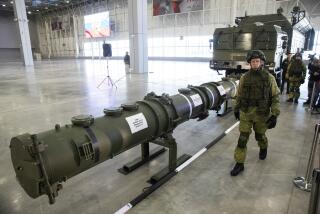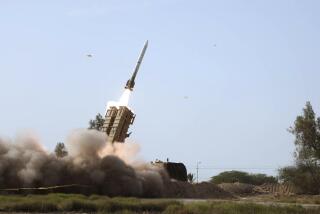The Fine Print Remains to Be Worked Out : Experts Tackle Arms Pact Details
- Share via
GENEVA — U.S. and Soviet delegates are working 12 to 14 hours a day, six days a week, to iron out by the end of November the many complexities of a draft treaty to eliminate intermediate-range nuclear missiles worldwide.
The broad principles of the treaty have been made clear, but the details are still to be worked out--and there are many of them.
“We always knew,” an American veteran of East-West talks said the other day, “that it would be a rat race at the end. It’s the way it always is in any important negotiation with the Soviet Union.”
He recalled the wild finale in Moscow, in May of 1972, of the negotiations that led to SALT I, the first of the strategic arms limitation treaties. President Richard M. Nixon and Henry A. Kissinger, his national security adviser, worked through the night to reach a deal with Leonid I. Brezhnev, the Soviet leader. The Soviets then insisted on an immediate signing on May 26, even though there had been no time to prepare the final texts in proper form.
Seven years later, in May of 1979, the final details of the SALT II treaty were still being ironed out in Geneva when President Jimmy Carter took off for Vienna to meet Brezhnev for a signing ceremony. The chief American negotiator at that time, Ralph Earle, arrived in Vienna with the final texts on June 14, days after Carter’s arrival.
A Different Approach
The Reagan Administration can be expected to try to organize things differently before Soviet leader Mikhail S. Gorbachev arrives in Washington, probably at the end of November. But there is still a long way to go on the four documents that will make up the agreement.
The four documents are the treaty itself, approximately 30 pages; a memorandum of understanding on the numbers and types of weapons to be eliminated; a protocol on how the process is to be carried out, and a protocol on inspection.
In Moscow, according to United Press International, Foreign Ministry spokesman Boris D. Pyadyshev said this week that the two sides have agreed on four of 16 sections in the draft treaty. He said Soviet negotiators believed that the work could be completed by Oct. 22, when Secretary of State George P. Shultz is scheduled to visit Moscow for talks with Foreign Minister Eduard A. Shevardnadze.
“The rhythm in recent days in Geneva gives grounds to believe that the delegations will succeed in doing the job within the said time limit,” Pyadyshev said.
In negotiations on the memorandum of understanding, the Soviet Union has yet to provide any data on the number of missiles it has and plans to destroy. Among the missiles involved are the SS-20, with a range of about 3,000 miles; the SS-4, with a range of about 1,200 miles; the SS-12/22, with a range of about 550 miles, and the SS-23 with a range of about 300 miles.
Western estimates put the total number of these vehicles at about 680, with about 1,600 nuclear warheads.
On the American side, the figures are much simpler: 108 Pershing 2 missiles with 108 warheads and a range of about 1,100 miles; 256 cruise missiles, carrying one warhead apiece, with a range of about 1,550 miles.
Each side is supposed to submit its own data in Geneva, together with precise locations of exactly where the missiles are stored or deployed. Each side will have the right to challenge the data provided by the other. As soon as the treaty is signed and comes into force, each side will have the right to carry out an immediate inspection of all the deployment sites or storage facilities in order to verify the count. But the exchange of data has not begun yet.
Huge Transport Vehicles
In negotiations on the protocol on elimination, the two sides are still discussing such questions as what to do about the huge transport vehicles that move the SS-20s and cruise missiles to their launch sites. Negotiators are discussing, for instance, whether these vehicles have to be destroyed along with the missiles--or whether they can be turned into, say, tank transporters.
Nor are the procedures for elimination of weapons yet fully defined. It has been agreed in principle that the nuclear warheads will have to be removed to laboratory facilities to be deactivated. Destruction of the solid fuels is another complex problem.
The issue of how the final elimination of all these components to be verified is also still under discussion. The inspection protocol will list all the missile sites and facilities that are to be opened to inspection by each side, and will spell out in precise terms how the inspection is to be carried out.
For example, the American cruise missiles in Europe are all sited at air bases or military reservations of the allied governments. When Soviet inspectors turn up at, say, Greenham Common Royal Air Force Base in England, they will be allowed to see the U.S. cruise missiles but nothing else.
The protocol will also cover the procedures and facilities for inspection of missile destruction and for the reinspection of abandoned missile sites and facilities. There is also the problem of short-notice inspections, as opposed to prearranged visits.
Finally, there is the argument over the timetable, which has been agreed to in principle but still must be translated into details. The United States wants the Soviet Union to eliminate all its shorter-range weapons, those with a range of between 300 and 600 miles, within one year. The United States has no weapons of this type. Starting in the second year, then, the elimination of the American missiles and the Soviet SS-20s and SS-4s would begin, to be completed within three years.
5-Year Process
However, the Soviets are sticking to a five-year period for getting rid of all the missiles, and they want the process to start simultaneously on both sides.
So, officials say, the two sides are trying to negotiate a timetable of “staged elimination”--so many weapons from each category on each side, step-by-step, each step to be monitored under the inspection and verification procedures.
“We are breaking entirely new ground with the Soviets in all this,” an American negotiator said. “It is vital that we get it all down in fine print and get it right, for we are probably setting precedents in arms control for a long while to come.”
More to Read
Sign up for Essential California
The most important California stories and recommendations in your inbox every morning.
You may occasionally receive promotional content from the Los Angeles Times.










